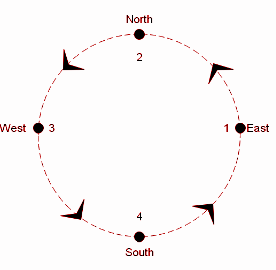
Answer
439.8k+ views
Hint: In a circular motion, the velocity of the object is always tangential to the motion of the object. And the acceleration of an object in circular motion is the resultant of radial and angular acceleration.
Complete step by step solution:
When a particle moves in a circular motion, its linear velocity is always tangential to the direction of its motion at that given point in the circular path. It is clear from the figure that when the toy airplane is at point 3, the tangent to its direction of motion will be downwards as the plane is moving in an anti-clockwise direction. While point 4 will have velocity in the east direction, point 1 in the North, and point 2 in the West.
On the other hand, the acceleration of the toy in a circular motion will be due to the resultant of the linear acceleration and the angular acceleration. But since the toy airplane is moving with constant velocity, it will have zero linear acceleration. The angular acceleration will be due to the centripetal force that acts on the airplane that acts in the inwards direction i.e. towards the center of the trajectory. So, the toy plane’s acceleration will be in the South direction, when it is in the North position i.e. point 2
So, the velocity will be downwards when the airplane is at point 3 and the acceleration will be downwards when it is at point 2 which corresponds to option (B).
Note:
In a circular motion, the velocity of the object is always tangential while the acceleration, in this case, is always towards the center i.e. perpendicular to the tangential direction which is why the particle travels in a circular trajectory. We must be very careful about taking the direction of the circular motion into account. If the trajectory had been in the clockwise direction, the point having a velocity in the downwards direction would be point 1 however the acceleration in the downwards direction would still be at point 2 since the acceleration of the plane is towards the center regardless of the direction of motion.
Complete step by step solution:
When a particle moves in a circular motion, its linear velocity is always tangential to the direction of its motion at that given point in the circular path. It is clear from the figure that when the toy airplane is at point 3, the tangent to its direction of motion will be downwards as the plane is moving in an anti-clockwise direction. While point 4 will have velocity in the east direction, point 1 in the North, and point 2 in the West.
On the other hand, the acceleration of the toy in a circular motion will be due to the resultant of the linear acceleration and the angular acceleration. But since the toy airplane is moving with constant velocity, it will have zero linear acceleration. The angular acceleration will be due to the centripetal force that acts on the airplane that acts in the inwards direction i.e. towards the center of the trajectory. So, the toy plane’s acceleration will be in the South direction, when it is in the North position i.e. point 2
So, the velocity will be downwards when the airplane is at point 3 and the acceleration will be downwards when it is at point 2 which corresponds to option (B).
Note:
In a circular motion, the velocity of the object is always tangential while the acceleration, in this case, is always towards the center i.e. perpendicular to the tangential direction which is why the particle travels in a circular trajectory. We must be very careful about taking the direction of the circular motion into account. If the trajectory had been in the clockwise direction, the point having a velocity in the downwards direction would be point 1 however the acceleration in the downwards direction would still be at point 2 since the acceleration of the plane is towards the center regardless of the direction of motion.
Recently Updated Pages
Who among the following was the religious guru of class 7 social science CBSE

what is the correct chronological order of the following class 10 social science CBSE

Which of the following was not the actual cause for class 10 social science CBSE

Which of the following statements is not correct A class 10 social science CBSE

Which of the following leaders was not present in the class 10 social science CBSE

Garampani Sanctuary is located at A Diphu Assam B Gangtok class 10 social science CBSE

Trending doubts
A rainbow has circular shape because A The earth is class 11 physics CBSE

Which are the Top 10 Largest Countries of the World?

Fill the blanks with the suitable prepositions 1 The class 9 english CBSE

Which of the following was the capital of the Surasena class 6 social science CBSE

How do you graph the function fx 4x class 9 maths CBSE

The Equation xxx + 2 is Satisfied when x is Equal to Class 10 Maths

Give 10 examples for herbs , shrubs , climbers , creepers

Difference between Prokaryotic cell and Eukaryotic class 11 biology CBSE

Who was the first Director General of the Archaeological class 10 social science CBSE





